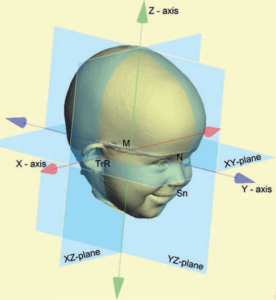Diagnoses for children with rare genetic diseases by 3-D facial scans

Last Updated on December 13, 2020 by Joseph Gut – thasso
 In a new and exciting development, an international team led by scientists and clinicians from the University of Colorado, University of Calgary, and University of California, San Francisco (UCSF) has developed a prototype tool based on three-dimensional (3-D) facial imaging that could shorten that diagnostic odyssey by making it easier for clinicians to diagnose genetic syndromes.
In a new and exciting development, an international team led by scientists and clinicians from the University of Colorado, University of Calgary, and University of California, San Francisco (UCSF) has developed a prototype tool based on three-dimensional (3-D) facial imaging that could shorten that diagnostic odyssey by making it easier for clinicians to diagnose genetic syndromes.
According to the researchers, families were telling them that having a diagnosis for their child’s rare disease was life-changing, In fact, a (correct) diagnosis is essential to children getting the right treatments and connecting with other children and families with the same syndrome.
Most developmental genetic syndromes affect multiple organ systems, and clinical geneticists have long relied on distinctive facial features as an important guide to diagnosis.
In a new study just published online in Genetics in Medicine, the research team created a unique library of 3-D facial images of participants of diverse ages and ethnicities, including 3327 children and adults with 396 different genetic syndromes, 727 of their unaffected relatives and 3003 other unaffected individuals from the United States, Canada, and the United Kingdom. The secure database is hosted by FaceBase, an international consortium funded by the National Institute of Dental and Craniofacial Research, part of the U.S. National Institutes of Health (NIH).
 The researchers then used this secure database to train a machine learning algorithm to identify most of the genetic syndromes included in the dataset with moderate-to-high accuracy. Based on facial shape, 96 percent of study subjects could be correctly classified as either unaffected or having a syndrome, and for most, the algorithm was able to provide a prioritized list of likely diagnoses with high accuracy.
The researchers then used this secure database to train a machine learning algorithm to identify most of the genetic syndromes included in the dataset with moderate-to-high accuracy. Based on facial shape, 96 percent of study subjects could be correctly classified as either unaffected or having a syndrome, and for most, the algorithm was able to provide a prioritized list of likely diagnoses with high accuracy.
The COVID-19 pandemic has accelerated a rapid shift to telemedicine by genetics clinics, including those at UCSF, University of Colorado, and University of Calgary, but the study team says the field still lacks tools to replace many aspects of the in-person physical exam. The automated diagnostic approach developed in this study could extend the ability of clinical geneticists to diagnose patients without requiring travel to a specialized clinic. It could also help general practitioners without genetic training to home in on potential diagnoses, enabling them to connect patients with appropriate specialty care and community support.
The researchers emphasize that the current study represents an important proof-of-concept for facilitating genetic diagnoses, but further work is required to deploy a clinically available, privacy-protected tool. Currently, the approach relies on expensive 3-D cameras, but this is expected to change with advances in smart-phone camera technology.
The researchers emphasise that they have designed a prototype with significant potential to become a clinical tool around the world. Their hope and goal is that one day soon, patients can securely take a photo of their face with a smart phone and send it to their doctor for analysis in a confidential database. Particularly in low-income countries where genetic testing and medical geneticists aren’t available, this could become a transformational new tool.
At thasso, we are fascinated about the diagnostic possibilities that arise from the combination of face recognition with genetics and it use in rare disease and/or patient phenotype analysis. It is for that reason that we had in the past already articles on “Face2Gene: tool using facial recognition, AI and genetic big data to improve rare disease diagnosis and treatment” (here), on “You cannot hide it: Your face tells all about your ID” (here), and on “Where portrait photos meet genetics and AI” (here).
See here a sequence on FaceBase, which may become very central to project presented here:

